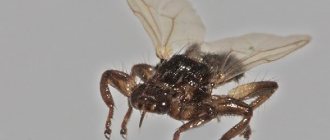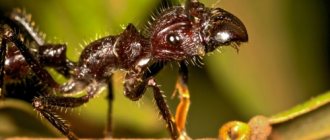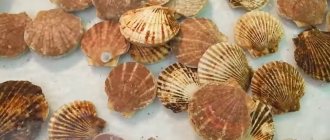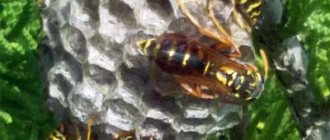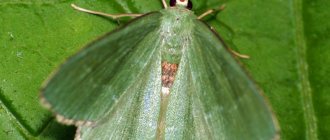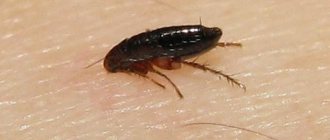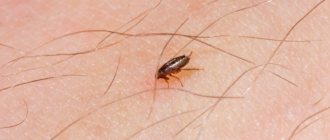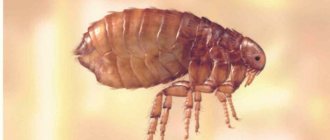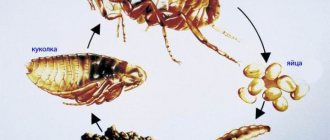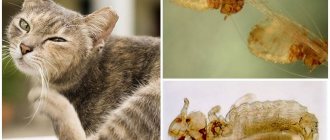What kind of fleas are there?
Scientists were able to identify, classify and describe more than 2 thousand species of fleas . But we are only interested in three of them:
- Dog fleas (Ctenocephalides canis).
- Felids (Ctenocephalides felis).
- Rat fleas (Xenopsylla cheopis).
It is worth briefly describing each of these types, how they differ from each other, and how dangerous they are to humans.
Dog fleas
Dog fleas live and breed in fur, which makes sense. Externally, dog fleas are similar to cat fleas, but they still differ from each other.
Dog flea bites are painful and cause characteristic itching and redness. Can carry dangerous bacteria and infections. Fleas get into the house on the fur of pets after another walk. A dog can become infected either from other animals or after going to an infected place. Fleas, without a constant host (food source), live well in the ground, sand or in the nests of birds and rodents.
Photo of fleas on a dog
Interesting fact! A flea colony consists of adult ectoparasites, larvae, eggs and pupae. At the same time, adult fleas make up only a small part of the colony - no more than 5-7% . This is important to know before you start fighting fleas.
Cat fleas
Fleas on a cat look (if you can see them) not much different from those on a dog. And they behave similarly. They settle in cat fur after another walk or meeting an infected animal.
Cat fleas bite humans with pleasure. Even if there is a constant source of food nearby or several (cats, dogs), a flea can bite a person. At the same time, flea bites are rarely located above the knees - where they jump, they bite.
A cat flea bite is painful and dangerous. It can cause infection with brucellosis or rickettsiosis. If you do not fight fleas, the colony quickly grows to obscene sizes, affecting the life of the residents of the house.
Rat fleas
Rat fleas pose the greatest danger to humans. This is because rats themselves are carriers of dangerous diseases, for example: tularemia, brucellosis or plague.
You can read more about rats in this article.
At the same time, fleas do not live on rats, more often in their nests, constantly feeding on their blood .
Rat fleas bite quickly and painfully. Flea bites are especially dangerous for children.
How fleas bite
Insects are characterized by their miniature size and brown body color. At first glance, the flea seems to be a very harmless creature, but in the photograph the parasite looks very terrifying. The entire body is covered with bristles, which help the bloodsucker to move imposingly in the fur of animals. The insect has three pairs of legs, the hind ones are much longer than the others. Thanks to this structure, the insect has good jumping ability.
Fleas, their eggs and larvae
The flea ranks second among insects in jumping ability. She can cover up to 30 cm during a long jump and up to 20-25 cm in height. If a person wanted to compete with the parasite, he would have to learn to jump up to 160 m in length.
The flea's oral piercing-sucking apparatus is designed to feed on blood. Unlike bedbugs, parasites do not pierce the skin of their victim, but literally saw through it with their upper jaws, while the lower jaws push the wound apart to introduce saliva into it. To reach the capillary, they have to immerse their head and body into the wound. A person feels flea bites immediately and experiences severe pain. This is due to the fact that the insect does not inject an anesthetic substance, as it is well aware of its invulnerability. During a meal, the parasitic individual with its saliva introduces a special enzyme into the wound, which prevents blood clotting. Its amount is negligible - only 0.000004 mm³, but this microscopic dose causes severe itching and swelling at the site of the bite.
Flea bites always form a chain consisting of 2-4 punctures, which is exactly how many one insect makes in one meal. Under favorable conditions and the presence of a constant food supply, parasites prefer to eat every day. In the absence of this, they can hibernate and remain in it for up to a year. After waking up, hungry insects attack their victims with particular zeal, as a result of which they can bite them fairly.
Flea bites
Can humans have fleas?
Nature is so generous that it has provided a separate type of flea for humans. It's called Pulex irritans . This species can live on a person for some time, but only in the case of a complete lack of hygiene of the latter. And human fleas are extremely rare. They reproduce in other places, only coming to Homo Sapiens to eat.
But dog, cat and rat fleas are very common. And they, without a twinge of conscience, bite a person, a small child, and even your parrot. These parasites are extremely gluttonous and indiscriminate in their taste preferences.
They bite painfully because they do not inject any substances during the bite, like mosquitoes or ticks, for example. And fleas don’t hide, but brazenly climb wherever they need to and dig their jaws into the skin. This is what a flea looks like at 20x magnification.
Photo of a flea under a microscope
Therefore, the answer to the question: “ Can fleas live on humans ?” - no, they can’t, but they drink his blood with pleasure, leaving itchy and painful wounds and, possibly, a couple of pathogens of dangerous diseases.
Types of fleas
Fleas are parasites that live on our cats, dogs, and birds. Someone keeps rats or rabbits and they also have these insects that can bite humans. Their bite is similar to a needle prick, after which the skin around it swells, like a mosquito. At the site of the bite, the person feels severe itching. Not all fleas bite humans.
There are also human fleas. They can parasitize felines or dogs, but their mouthparts are designed so that they can pierce human skin. This is why they are most comfortable sucking human blood. Fleas can multiply in our home, in order to completely remove them, it is necessary to treat both the carrier and disinfect the apartment.
The fleas of our feline pets do not live permanently on the human body; they are only capable of jumping on and biting. They drink blood and leave. They also love to jump on fleecy surfaces.
There are a huge number of flea species in the world; to be precise, there are about 2000 varieties. But not all of them, if you do not take into account the human one, are capable of sucking blood from people.
Species dangerous to humans
Let's look at species that can bite through skin and feed on human blood:
- Canine. Those who keep dogs should give them flea prevention once every six months. Dogs often carry these insects and they are among those that can bite humans.
- Feline. Like animals, they are distributed throughout the world. They bite humans as often as dogs. They can jump off your pet and when you pass by, they jump onto your legs, climb higher up your legs, onto your arms, back, and head. Most often, such insects bite feline owners living in an apartment. In the village it is not customary to let cats into the house for a long time; the parasites attack passers-by.
- Rat. They rarely affect city dwellers; more often their victims are residents of regional centers and villages. This is why their bites are dangerous, since everyone knows that rats carry many infectious diseases.
- Rabbit. These insects are common, but they rarely affect people.
Fleas that parasitize pets and even birds can bite people. If for some reason they leave their owner, then when they are hungry, they will definitely try to pierce your skin and drink blood. Therefore, if you notice a flea indoors, you need to disinfect the entire apartment or house.
The insect will drink plenty of blood in 1 - 3 bites in different places. The bug bites several times around one place. It is imperative to get rid of these parasites indoors.
Human flea
What does this type of flea look like? They are from 1 to 4 mm, nimble, and actively breed. The individual is almost black, flattened on the side. A small head with a mustache on it. The mouth has spines and is adapted for sucking blood. The insect jumps to a height of 50 to 100 times its size. Such champion jumps are possible due to the long hind legs with claws. She has a total of 3 pairs of legs. When a person moves, it clings perfectly to the skin or hair with its claws and holds on. Fears of losing the “breadwinner”.
Fleas lay eggs indoors. Floor cracks, rug or carpet pile, and any debris are suitable for this. During its life, one individual can lay up to 500 eggs. The offspring will hatch in 2 - 3 weeks. The young will jump on any warm-blooded animal or people who pass by. They need to profit from blood and gain strength. If the owner is away for a long time, the flea can wait and live hungry for 21 days.
The first signs of fleas in the house
Fleas can get into your house not only through our little brothers, you can bring them yourself. These parasites often live in dark and damp places. For example, a basement or barn.
The only condition for the survival of the colony is regular nutrition . And this is usually no problem, since mice, rats, and sometimes cats and dogs live well in the same places. Therefore, fleas can be brought into the house with some item, for example, with an old carpet from a long-forgotten basement.
How to understand that you have fleas in your apartment . There are several obvious and not so obvious signs:
- The main sign of fleas appearing in your home is bites, and not just single ones. When the flea gets to the victim, it can bite 10-30 times.
- Mostly fleas bite on the legs, but if your pets sleep in bed with you, and the colony of parasites has grown to impressive sizes, flea bites will be on the back, on the arms, and even on the face.
- The second obvious sign of the appearance of fleas in your home is that the cat or dog begins to scratch itself frequently and diligently.
- You may also occasionally see fleas. Of course, this is extremely difficult to do because of their size, but with a large number of parasites in the house, sometimes you can notice their movement.
Photo of a flea compared to a human finger
What do flea bites look like on a person?
Flea bite marks are often confused with bites from bedbugs, lice and mosquitoes. Small red itchy blisters appear on the body, which after a while turn into sores. Swelling may not disappear for up to two days, and in the case of an allergic reaction, even for several weeks.
Most often, fleas bite in the area of the lower extremities: feet, legs, ankles. Exposed areas of the body are rarely attacked. If a flea attack occurs on a sleeping person, then bites can appear all over the body (on the neck, armpits and even on the face). In such cases, they are often confused with bedbugs.
Bedbug bites differ from flea bites in that the parasites leave a characteristic trail. Fleas bite randomly. Flea bites are located at close and unordered distances from each other.
From the above, we will make a list of the main symptoms:
- acute pain;
- characteristic redness on the skin in the form of small swellings, randomly located from each other;
- the main area of attack is the lower limbs;
- severe itching.
Svetlana Tolstova
Infectious disease specialist, therapist with 15 years of experience in a city clinic.
In some cases, flea bites can cause allergic reactions in the form of dizziness, fever, enlarged lymph nodes and suppuration of the damaged skin area. You should be extremely attentive to the manifestation of symptoms, especially in young children, in order to prevent angioedema.
Consequences of flea bites (photo)
As already mentioned, fleas bite several times. The nature of the bites is chaotic. Compared to a bedbug bite, which makes a trail of bites, fleas bite very chaotically. Wherever it can be reached, it bites.
Let's imagine a few photos of what a flea bite looks like.
A flea bit my hand
Fleas bit my leg (photo)
Prevention measures
To protect your home from the penetration of dangerous insects, it is enough to adhere to preventive measures:
- Keep your home clean, paying due attention to hard-to-reach areas.
- Seal cracks in baseboards, window sills, and trim.
- Buy flea collars for your pets.
- After each walk, thoroughly wash and dry your pet's paws.
- Wash the rug lying by the front door and the dog or cat bedding as often as possible.
- Keep bouquets of plants that repel fleas in the house: wormwood, mint, tansy, calamus, etc.
- Once a month, wipe all surfaces in the house with a soda-soap solution.
- When going to places where parasites may accumulate, you need to dress in such a way as to block access to your body.
Having discovered at least one parasite in your home, you should not let the situation take its course. It is important to remember that fleas multiply very quickly and in just a week, hungry hordes of insects will literally “gnaw” the inhabitants of the apartment.
So, if bloodsuckers do appear, you need to call specialists from sanitary and epidemiological services to combat them.
Sources
- https://apest.ru/blohi/vse-o-blohah/ukusy-bloh-na-cheloveke/
- https://geradez.ru/kak-vyglyadyat-ukusy-blox-ru
- https://otravilsya.com/ukusy/blohi/
- https://healthperfect.ru/ukus-blohi-na-cheloveke.html
- https://ProVyzhivanie.ru/pervaya-pomoshh/ukusy-bloh
- https://notklop.ru/blohi/o-blohah/ukusy-bloh-na-cheloveke/
[collapse]
How can you become infected after a flea bite?
Let us immediately make a reservation that the transmission of pathogenic bacteria does not occur with every flea bite. According to statistics, approximately every hundredth to two hundredth bite can be infectious and potentially dangerous . Much depends on the conditions in which you live, in which city, country.
But one thing is known for sure - the more and more often fleas bite you, the higher the likelihood that some helminths will still settle in your body, whether you want it or not . Next, we’ll tell you where and what you can get infected with.
Plague
We have already partially mentioned this terrible disease, so we will not focus on it. Let us just add that the pain is not pleasant. The incubation period lasts from 5 to 8 days.
Interesting fact! In all three global plague epidemics (in the 6th, 14th and 19th centuries), the carriers of the Yersinia pestis plague bacilli were fleas that bit infected rats.
There are three types of plague:
- bubonic – it is the most common and best treatable;
- pneumonic plague - characterized by extensive damage to the lungs, pneumonia (extremely contagious and is a moderate form in severity);
- septicemic is the most difficult form for both the patient and doctors, since it is difficult to treat and often leads to death.
Let us remind you once again that in our time the plague is extremely rare, and, as a rule, in remote regions and countries. There is no need to be afraid of it, but it doesn’t hurt to be informed.
Hymenolepiasis
Hymenolepiasis is a worm that lives in the large intestine. In every second case, the disease is asymptomatic. Moreover, parasites can live in the body for quite a long time until they are identified (stool analysis) and destroyed by one of the modern antibiotics.
What symptoms may appear:
- heartburn;
- nausea;
- skin rash;
- diarrhea;
- dizziness;
- lack of appetite;
- severe periodic abdominal pain;
- Quincke's edema is possible.
It is treated relatively easily and without consequences.
Typhus
The causative agents of typhus are also transmitted from infected animals to humans through the bite of a flea. The disease is accompanied by symptoms such as:
- increased body temperature;
- feverish condition;
- hence the confusion, delirium;
- typhus can severely damage the central nervous system (CNS);
- affect the normal functioning of the cardiovascular system.
The disease is quite dangerous, but if you diagnose it in time and start timely treatment, then everything will be fine.
Tularemia
Tularemia is a dangerous zoonotic infection transmitted from animals to humans. The route of transmission is the same fleas , but not only them.
If the disease is allowed to develop, the kidneys, lungs and intestines are likely to be affected. The eyes may also be affected. Suppurations will begin to appear on the body. Severe inflammation of the lymph nodes is often observed .
The symptoms of the disease at the beginning of its development are very similar to a common acute respiratory infection: headache, fever, body aches, etc. Should you see a doctor? Undoubtedly! This could save your life.
Let us remind you! The advice to go to the hospital is not an empty call! Any infectious or bacterial disease requires medication, often inpatient treatment. Don't ignore modern medicine.
Helminths
Very unpleasant and very dangerous parasites. They happily settle in the large intestine, beginning to actively reproduce. The symptoms are similar to hymenolipedosis, we will not repeat it.
Helminths can harm the body by reducing immunity. If they are not detected in time, and if concomitant diseases that arise against the background of reduced immunity are treated independently, the story can end very badly.
These are not all diseases transmitted through flea bites. There are more of them, much more. But all of them are either extremely rare or located in subequatorial countries. For example, many subspecies of intestinal parasites live in Africa, India, and parts of Asia. We don't have those.
Treatment methods
A flea bite on a person (a photo and description of which is usually enough to recognize it) most often does not require any specific treatment, and the main methods of therapy come down to independently eliminating the unpleasant consequences after it.
Medications
For flea bites, you should use products that relieve itching and disinfect damaged areas of the skin.
They are usually available in the form of ointments, gels, and solutions for external use:
- Sulfur ointment is an antipruritic drug with antiseptic properties. You can apply it to the affected areas up to 3 times a day, but not more than 5 days. Not suitable for use by children under 3 years of age. Cost – from 20 to 50 rubles.
- Fenistil gel is a remedy for various insect bites and allergic reactions that occur, which can be used by children (over 1 month of age). The ointment is applied 2–4 times a day until symptoms disappear. Price 400 – 800 rub.
- Sinaflan - hormonal ointment has decongestant and antibacterial properties, soothes irritation after insect bites. Apply to the affected areas 1 – 3 times a day, for no more than 5 days. Use in infants is permissible under medical supervision. Price 50 – 90 rub.
- Flucinar gel is a potent hormonal drug, approved from 2 years of age. It is recommended for adults to apply the gel 2 times a day, for children – 1 time, in a thin layer. The duration of use should not exceed 5 days. Not recommended for use on the face. Cost 200 – 400 rubles.
- Hydrocortisone 1% is a hormonal ointment for severe itching and irritation, used similarly to Flucinar. Cost 20 – 60 rubles.
- Zinocap ointment - indicated for rashes, including dermatitis and neurodermatitis, up to 3 times a day. Suitable for use in children over 1 year of age. Cost 300 – 800 rub.
- Balm Golden Star - used in liquid form, rubbed into the affected areas to relieve pain and irritation. It is recommended to apply immediately after the bite every 20 - 30 minutes. until the discomfort is completely eliminated. Price 100 – 200 rub.
- Psilo-balm is a gel to eliminate swelling and itching with a cooling effect. Use up to 4 times a day; children are allowed from 2 years of age. Cost 250 – 350 rubles.
- Levomekol - gauze dressings with ointment are used for suppuration at the sites of insect bites until the purulent-necrotic contents are completely pulled out from the wound. Allowed for children from 1 year of age. Price 100 – 160 rub.
- Miramistin is an antiseptic and anti-inflammatory agent, applied to bite sites up to 4 times a day, regardless of the patient’s age. Cost 250 – 800 rubles.
- Menovazin is an alcohol solution to eliminate itching, has a soothing cooling effect and contains a small dose of the anesthetic novocaine. It is used up to 3 times a day, and the total duration of the course can be 3 – 4 weeks. Price 12 – 40 rub.
In addition to the above drugs, you can disinfect a bite using alcohol, chlorhexidine, iodine, and brilliant green solution.
In order to prevent the occurrence of an allergic reaction from a bite or if signs of one appear, you should immediately take antihistamines (Zodak, Suprastin, Zyrtec, Cetrin, Loratadine, Tavegil). It is recommended to give them to children in advance, regardless of existing symptoms.
Traditional methods
Traditional methods for flea bites are effective as first aid measures for minor rashes and the absence of allergic reactions. These are affordable products that are always at hand and can temporarily replace medications that are not available in the house.
First aid for bites consists of disinfection and removal of swelling:
- wash the bite site with antibacterial or regular laundry soap;
- apply an antiseptic;
- Apply a cold gauze compress or ice to the damaged area of skin.
Next, you need to use painkillers and anti-inflammatory drugs:
- Mix baking soda with water to a paste consistency, apply the paste to the bite area and let it dry.
- For children, you can prepare a less concentrated alkaline solution with soda in a proportion of 1 tsp. soda per glass of water. Apply a lotion to the affected areas.
Folk remedies with soda help neutralize toxins contained in insect saliva and prevent the development of an allergic reaction, so they are most effective immediately after a bite.
- Acid-containing products such as lemon or vinegar have disinfecting properties and can prevent the development of infection. To prepare the solution, mix 1 part lemon juice (or apple cider vinegar) with 2 parts water and apply it to the affected skin.
- Aloe juice has soothing and regenerating properties. It is used in its pure form, lubricating bite wounds up to 3 times a day or applying a fresh leaf (after cutting off the top layer of skin on one side) as a compress.
- Black tea is known for similar properties. For bites, you can use regular tea bags, freshly brewed and cooled until warm. The lotions should be kept on the skin for at least 3 minutes.
- Compresses from decoctions of medicinal herbs (calendula, aloe, plantain, coltsfoot, string, chamomile) help eliminate pain and relieve inflammation. For cooking you need 2 tbsp. l. Pour a glass of boiling water over any pharmaceutical plant and cook in a water bath for 10 - 15 minutes. Allow to cool slightly and apply warm (but not hot) lotions to the skin until the composition cools completely.
- Honey for bites is used as an antimicrobial agent that neutralizes toxins. It is applied to the skin in its pure form and left for up to 5 minutes.
Other methods
In the event of an allergic reaction to a bite or an exacerbation of a chronic form of an allergic disease as a result of insect bites, the main methods of therapy are supplemented with physiotherapy:
- electrophoresis or ultraphonophoresis - administration of medications using current or ultrasonic pulses;
- UV radiation and intravenous laser irradiation - used to change blood counts and relieve pain;
- darsonvalization - exposure to current pulses for an antiseptic effect and acceleration of the healing process.
Patients suffering from chronic allergic diseases should periodically visit salt rooms (speleotherapy) and undergo mud therapy procedures.
Also, for any skin rashes (including chickenpox, dermatoses, rubella) and to relieve itching, children are prescribed a cosmetic product with natural ingredients - calamine lotion for external use. It is rubbed into the affected areas 3 to 7 times a day, according to the doctor’s indications.
How to get rid of fleas in an apartment
The question of how to get rid of fleas in an apartment usually arises when the situation is advanced. We strongly advise against acting on your own . And the point is not that a person cannot cope with fleas. There are modern aerosols and sprays against fleas. The point is different: professional pest control will kill all parasites, including those living under the baseboards, under the carpet, in mouse holes or in small cracks.
Therefore, if you have the opportunity to pay for the services of the sanitary and epidemiological service, do it !
We do not advertise any company, we simply recommend the most effective option.
Reviews and comments
+8 jrcfyoksana 05.12.2015 18:22 redness but I don’t see any signs of bedbugs or fleas anymore and I washed everything and ironed it, nothing helps, I go to bed which I also carefully ironed, and then again this feeling that something is crawling up my body, biting me though there is no pain, the bites look like an allergy, and at the same time, in your photo, I’m shocked and don’t know what it could be.? Why and where do fleas appear? There haven’t even been cockroaches in the apartment for 20 years. Maybe it’s just because of nervousness?
Quote
+4 Irina 05/23/2017 21:32 I constantly encounter fleas.
And only me. In completely different places. At home, at work, at the bus stop, I’m not me if I don’t collect all the fleas. I react painfully to their bites: the skin swells and itches very much. There are other people in the same places next to me, fleas do not bother them. Sometimes you even have to show this insect: “Look, look: a flea.” I wonder what is the reason for such “food” selectivity of these reptiles? Blood type? Thin skin? Or something else? And how can I protect myself from bites? Quote
Preventive methods of protection
It is impossible to protect yourself from fleas if they have already entered your apartment. All that remains is to deal with the consequences. However, you can take care to prevent fleas from entering your home.
Some tips:
- Disinfest the basement, barn, and outbuildings. For those who live in a private house.
- Be sure to wear special collars on your pets . They do not kill fleas, but drive them away. Do not forget to change collars on time, according to the instructions.
- The same applies to the use of flea shampoos. They can be used regularly.
- Do wet cleaning regularly using household chemicals.
As you can see, the main idea is to keep fleas out of your home. And if they do get into the apartment, call specialists. You can, of course, try to get rid of fleas yourself using Raptor, GET and other means. But if this does not help, then specialists will deal with the problem.
Why are rat fleas harmful?
They feed not only on rat blood; people and animals are also not protected from their painful bites. The affected area often becomes inflamed, festers, and swells. An allergic reaction is possible. Repeated bites can cause inflammation of the lymph nodes, headaches, mouth ulcers and nervous breakdown.
This is not the worst thing, because they are carriers of plague, encephalitis, brucellosis, salmonellosis, and anthrax. Rat and mouse fleas carry helminth eggs.
Preventive measures
Rat fleas thrive in places where there is accumulation of dust and dry debris; therefore, regular cleaning of residential premises . Particular attention should be paid to bedspreads, upholstered furniture, carpets, and bedding, on which pets often rest. In a private home, it is also recommended to clean basements and cellars.
In the same situations, if you have to be in places where attacks by rat fleas and ticks are possible, it is necessary to use insecticidal insect repellents. The most common and effective are aerosol preparations based on the insecticide DEET, which repels both fleas and ticks.
In addition, to protect yourself from fleas and ticks when going outdoors, it is recommended to wear long pants and try to avoid spending long periods of time near animal bedding areas and rodent burrows. During business trips or travel, it is better to avoid staying in cheap lodging houses and hotels, which are usually infested with various parasites.
